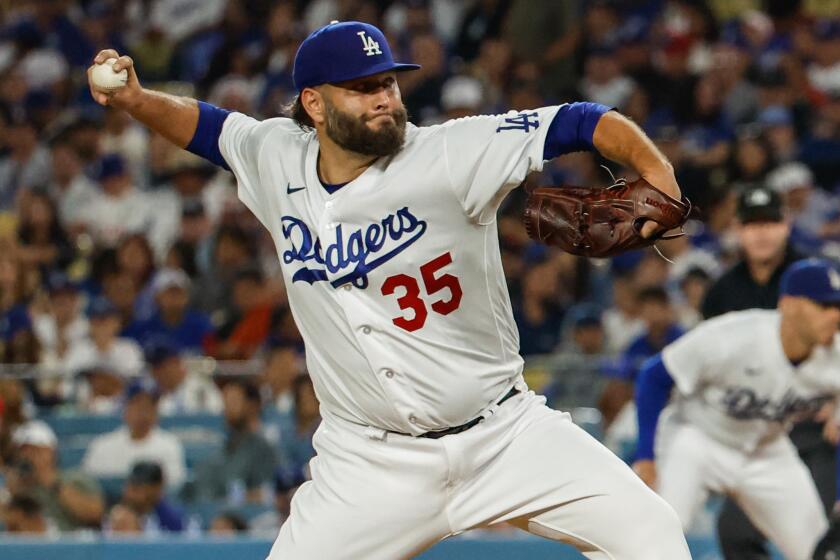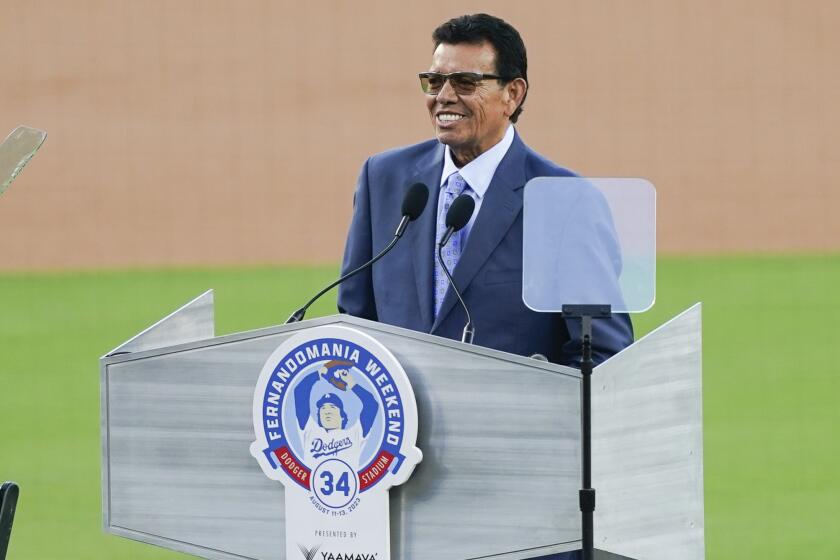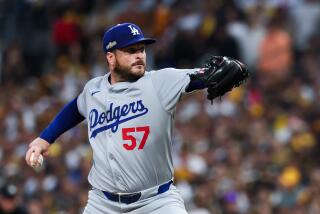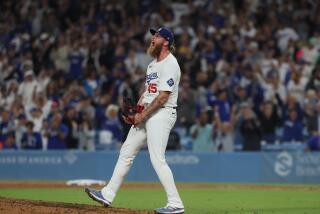Dodgers reliever Ryan Brasier’s lasting motto: ‘I just kind of kept going’
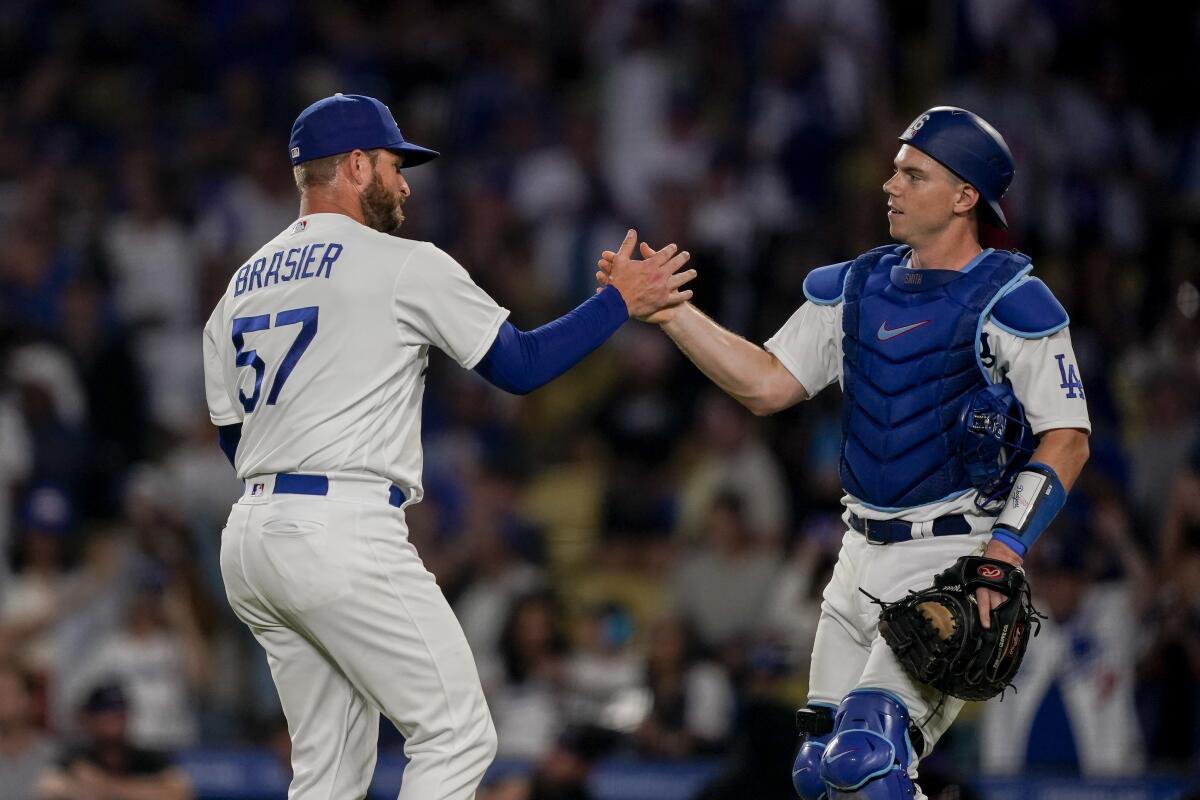
- Share via
A tiny scar, barely a quarter-inch long, on the top of his right ear belies the damage that a baseball did to the head of Dodgers reliever Ryan Brasier two years ago.
The 35-year-old right-hander, then with the Boston Red Sox, was in the final stages of his rehabilitation from a calf injury when he was struck on the right side of his head by a 104-mph line drive during an intrasquad game on June 4, 2021, at the team’s spring-training facility in Fort Myers, Fla.
“It ripped my ear off to the side, I had a big gash on my head, a cracked skull, bleeding on my brain, a bad concussion, some ringing in my ears,” Brasier said almost matter-of-factly, as if he was describing a minor ankle sprain. “It was pretty serious.”
Even more remarkable is that Brasier suffered virtually no mental scars from a scary incident that can be traumatic and sometimes career-altering for pitchers, one that so shook up Alex Cora that the Red Sox manager asked reporters to pray for Brasier after telling them what had happened.
Brasier, who spent part of his 36-hour hospital stay in the intensive care unit, returned to the big leagues in early September 2021 and went 1-1 with a 1.50 ERA in 13 games over the final month of the season.
He pitched in seven playoff games as the Red Sox advanced as a wild-card team to the American League Championship Series, losing to the Houston Astros in six games.
Lance Lynn puts in another strong start as the Dodgers defeat the Colorado Rockies 6-1 on the night Fernando Valenzuela’s number is retired.
Brasier pitched a full season in 2022, going 0-3 with a 5.78 ERA in 68 games for the Red Sox. He struggled in his first 20 games for Boston in 2023, going 1-0 with a 7.29 ERA, and was designated for assignment on May 15.
Brasier signed a minor league deal with the Dodgers on June 5, was promoted to the big leagues on June 20 and has since emerged as a valuable high-leverage reliever for the National League West leaders, going 2-0 with a 1.79 ERA and one save in 20 games through Friday night’s win over the Colorado Rockies.
“Honestly, from Day 1, the goal was to not flinch on a comebacker,” Brasier said. “I wanted to get ahead of it before I even picked up a baseball again. I felt like if I could get over that hurdle, then it would be pretty easy to get back into the swing of things, and that’s what happened. I haven’t flinched. I just kind of kept going.”
That last sentence could serve as Brasier’s mantra for a 17-year professional career that began in 2007, when he was a sixth-round pick of the Angels out of Weatherford Junior College in Texas, and has featured some extreme highs and lows, with little in between.
Pitch parts of seven seasons in the minor leagues before finally being called up by the Angels in 2013? Brasier just kept going.
Go four more years without a big league appearance, a stretch in which he was released by the Angels after 2014 and Oakland Athletics after 2016, had Tommy John surgery and pitched the 2017 season in Japan? Brasier just kept going.
Get let go this season by the team you won a World Series with in 2018, when going 2-0 with a 1.60 ERA in 34 regular-season games and giving up one earned run in 8⅔ innings of nine postseason games as a key setup man for closer Craig Kimbrel? Brasier just kept going.
“That’s just the game, man,” Brasier said. “Getting released by Boston, yeah, it hurts your pride, but you have to keep plugging away. The Dodgers gave me a chance to show what I can do, and with a few little fixes and a new pitch … it seems to have made all the difference.”
Friday’s number retirement ends a persistent debate about Fernando Valenzuela’s place in Dodger history, but is Valenzuela a Baseball Hall of Famer?
Brasier had relied almost entirely on a four-seam fastball that is averaging 95.4 mph and has touched 98 mph this season and an 85-mph slider, while mixing in occasional changeups and sinkers. The Dodgers suggested he start throwing a cut-fastball, believing it would give him another weapon against left-handed hitters.
The 91.3-mph cutter hasn’t been a dominant pitch for Brasier — opponents are batting .278 (five for 18) with three strikeouts in at-bats ending with it — but it has put a another pitch in the minds of hitters, who are batting .138 (eight for 58) with 20 strikeouts in at-bats ending with Brasier’s slider.
The cutter has also improved Brasier’s effectiveness against left-handers, who are batting .277 (18 for 65) with an .824 on-base-plus-slugging percentage against him this season after hitting .306 (22 for 72) with a .906 OPS in 2022 and .474 (nine for 19) with a 1.230 OPS in 2021.
“The cutter has been huge,” Brasier said. “I started throwing it right after I signed, and it kind of caught on pretty quick. Instead of being a two-pitch pitcher, I’ve added that third pitch to give them something else to think about.”
Brasier has held opponents to a career-low .145 batting average and .462 OPS with the Dodgers, striking out 18 and walking seven in 21⅓ innings after closing Friday night’s 6-1 win over the Colorado Rockies with a strikeout of Michael Toglia.
He was called up by the Dodgers for depth but has worked his way into a higher-leverage role, joining what manager Dave Roberts calls his “trust tree” of relievers in front of closer Evan Phillips, a group that includes Brusdar Graterol, Caleb Ferguson and recently acquired right-hander Joe Kelly, a 2018 Red Sox teammate of Brasier’s.
“He’s had a tremendous impact — I didn’t know a whole lot about him, but a comparable would be what Chris Martin did for us last year,” Roberts said, referring to the veteran right-hander who was acquired from the Chicago Cubs at the 2022 trade deadline and went 3-1 with a 1.46 ERA in 26 games for the Dodgers.
“He’s a guy you can trust in any spot. I love the compete. I love the pulse. He doesn’t get too high. He doesn’t say a whole lot. But whatever we’ve needed from him, he’s done. So for me, he’s been a pleasant surprise.”
None of this would have been possible had Brasier not recovered both physically and mentally from that line drive to the head, but it’s not as if the pitcher has erased that incident.
Brasier is reminded of it every time he puts on his carbon-fiber and Kevlar-lined cap, which he continues to wear for the extra layer of protection it provides.
“I’m so used to it, it’s like it’s not even there,” Brasier said of the thicker, heavier cap. “Getting hit in the head by a line drive is one of those things that happen on the field, though not very often.
“Guys get hit on the hand or the wrist, they break a bone, and they come back. Obviously, this was more serious, but when it happened, I knew I was gonna pitch again. To me, it was just another injury to come back from.”
More to Read
Are you a true-blue fan?
Get our Dodgers Dugout newsletter for insights, news and much more.
You may occasionally receive promotional content from the Los Angeles Times.

